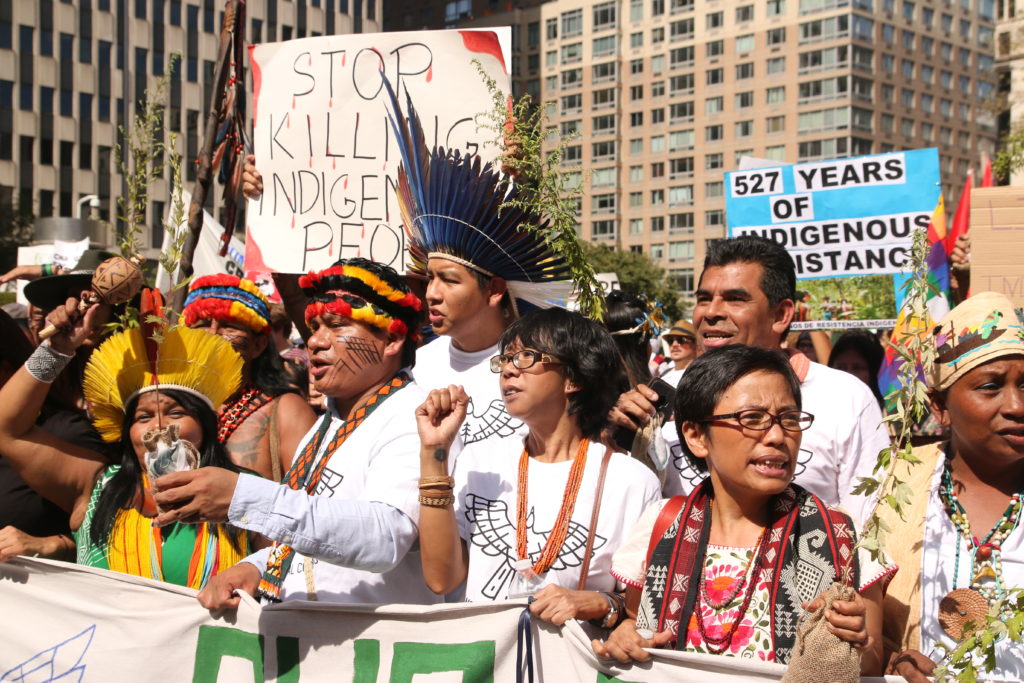Climate Action
Youth climate strikes break records worldwide
September 20, 2019
An estimated 250,000 people, mostly youth, showed up in New York City today to send a message to leaders: The planet is in a climate emergency, and young people will not sit by and do nothing.
Holding signs that read “Respect Your Mother (Earth),” “The Climate Crisis is Now” and “It’s Time to Panic,” young people took to the street, gathering in Foley Square in Lower Manhattan for a rally before marching to New York’s Battery Park.
Between chants of “We are unstoppable, a better world is possible,” climate activist Vic Barrett took to the stage to lament and protest the injustice of the uninhabitable earth he is inheriting.
“I was born into a culture that has been stolen from us,” said Barrett, a plaintiff on the constitutional climate lawsuit Juliana v. U.S. “This is our time. This is our future.”

New York City hosted America’s largest climate strike, but around the world, an estimated 4 million people from all seven continents (yes, even Antarctica) took to the streets to support the movement. The strikes were largely inspired by the Fridays for Future movement, started by Swedish climate activist Greta Thunberg just over a year ago.
“We will not just stand aside and watch,” said Thunberg at the New York rally. “We are united behind the science, and we will do everything in our power to stop this crisis from getting worse, even if that means skipping school or work, because this is more important.”
In a surprising show of solidarity, New York City Public Schools supported the strike, encouraging teachers and classrooms to join the march in an announcement made the previous week.
“If we don’t fight then nothing is ever going to change,” said Nadia, a sixth-grade student from Brooklyn. “And things can change, but what we need to do is take action. If we participate in protests and strikes like this, then every single person can help to make this situation better.”
The protests come after a decades-worth of disturbing (and largely ignored) reports from the Intergovernmental Panel on Climate Change. One of the most referenced reports came last year, warning that we have only 12 years to slow the most destructive aspects of climate change.

In 12 years, the high school students that rallied today won’t even be out of their 20s. A planet ravaged by climate change isn’t a distant future for them. It’s their whole life. That’s why the climate movement has been mostly driven and organized by young people.
Seventeen-year-old climate activist and Zero Hour founder Jamie Margolin also attended the New York strikes. Margolin has led her own youth climate movement for several years now, mobilizing tens of thousands of youth across the country with her nonprofit Zero Hour. Margolin shared her perspective on climate change, its causes and the potential for the youth climate movement to drive the solutions in an op-ed published in the New York Times today.
“I am trying to send leaders the message that this is Zero Hour to act on climate change. We have no more time,” said Margolin to Earth Day Network on Monday. “I am here striking and telling leaders to stand up for what really matters: The Amazon rainforest, my future … because people are dying, and it is important that they step up and give a damn.”
Multiple reports and studies have shown that worst impacts of climate change can be slowed through better management of land and preservation of biodiversity, especially in places like the Amazon. In recent years, the role of indigenous knowledge has risen in the public consciousness as an important climate solution as scientists and civil society alike recognize the unique, long connection that these first peoples have to the forests and lands.

“We are connected with nature, we live within nature, we are the ones who have been guarding the forests for the longest generations, for [millennia],” said Michael McGarrell, of Coordinator of Indigenous Organizations of the Amazon River Basin, at the rally.
Several hours into the rally, the strike at Foley Square transitioned into a march down Broadway and concluded as a rally in Battery Park, where Jaden and Willow Smith headlined a concert attended by thousands. Fridays for Future founder Greta Thunberg closed the event with a call to arms.
“Together and united, we are unstoppable,” said Thunberg. “This is what people power looks like. We will rise to the challenge. We will hold those who are most responsible accountable. We can, and we will.”
The strike comes a day before heads of state convene in New York for a week of major events at the U.N., including the U.N. Youth Climate Action Summit and the Climate Action Summit. The summit is a way for countries to get more nations on track to meet the standards set at the 2015 Paris Climate Change Agreement. For leaders of countries uninterested in cutting emissions and reversing the trends of global warming, Thunberg has a simple message.
“This is just the beginning,” said Thunberg. “Change is coming, whether they like it or not.”